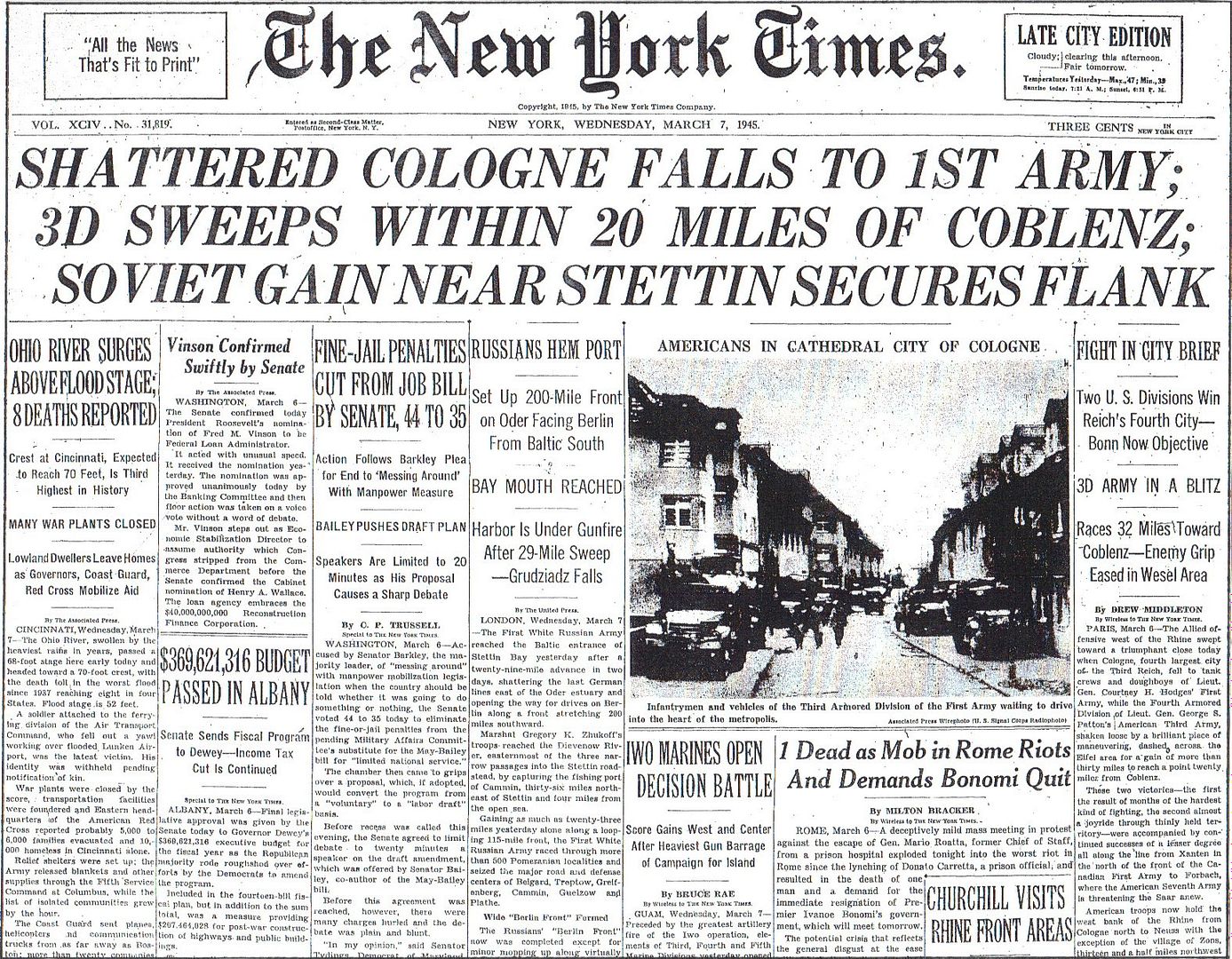
Posted on 03/07/2015 4:59:29 AM PST by Homer_J_Simpson

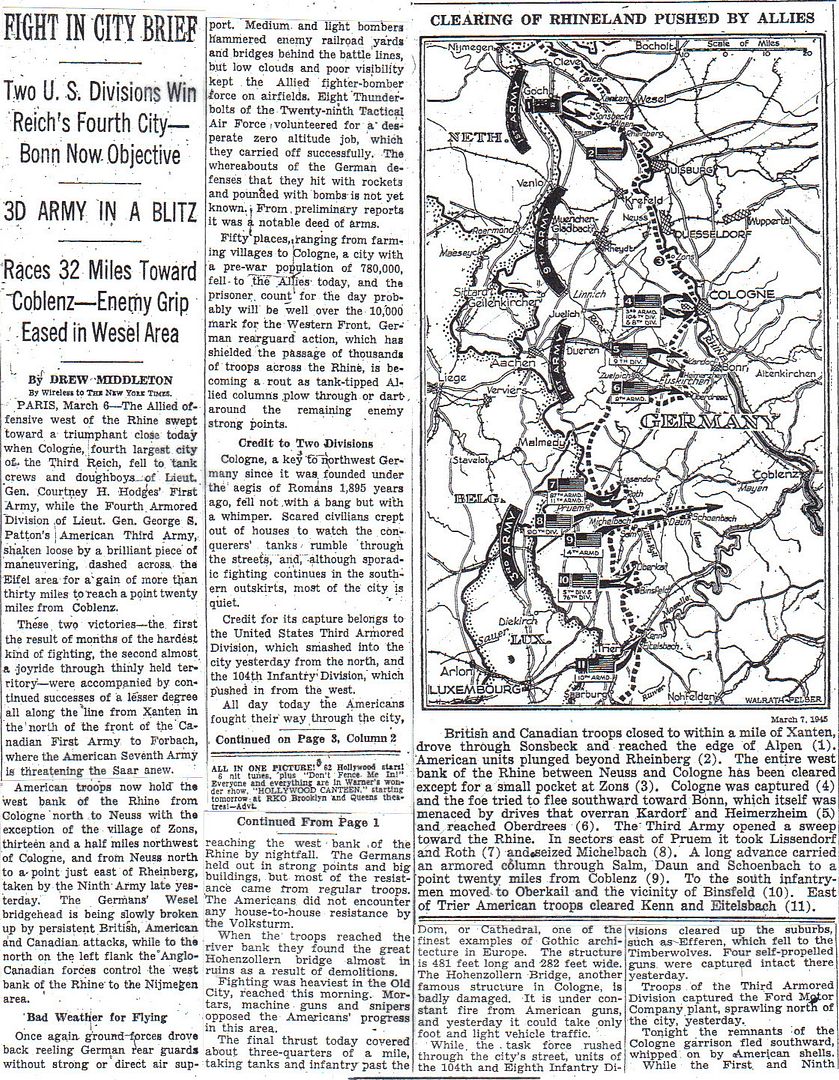
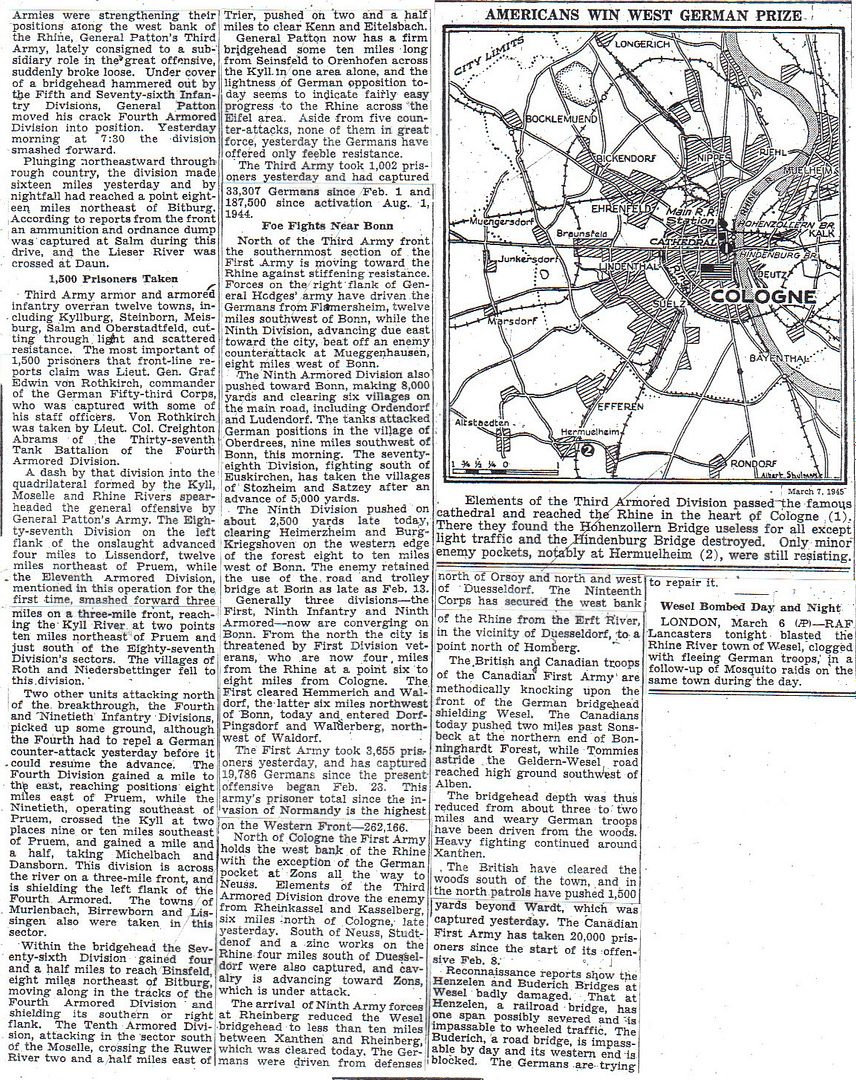
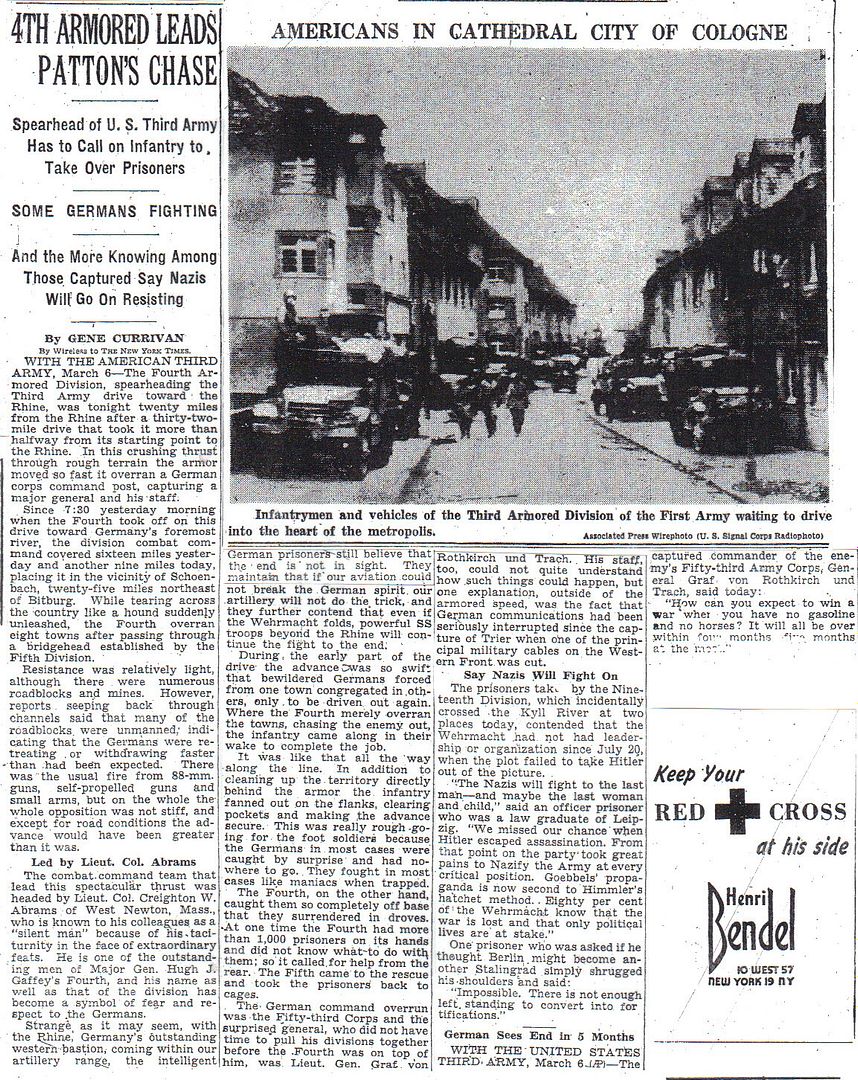
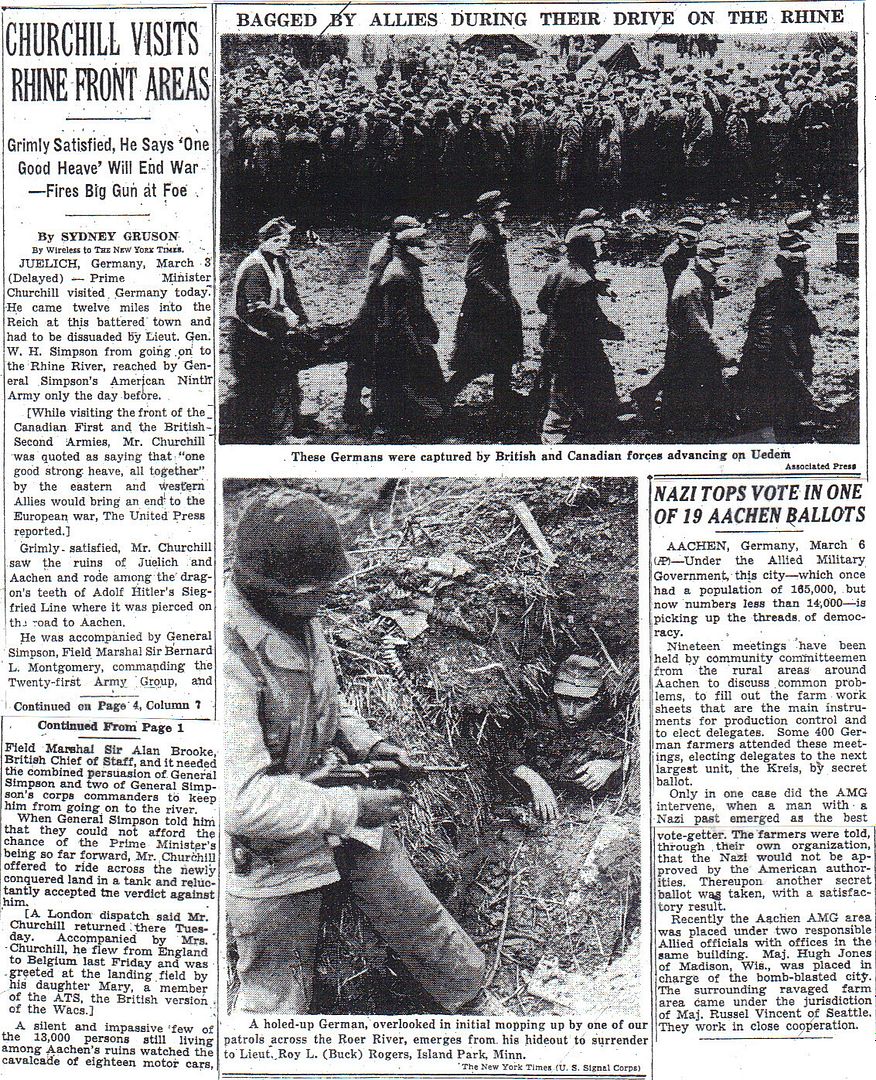

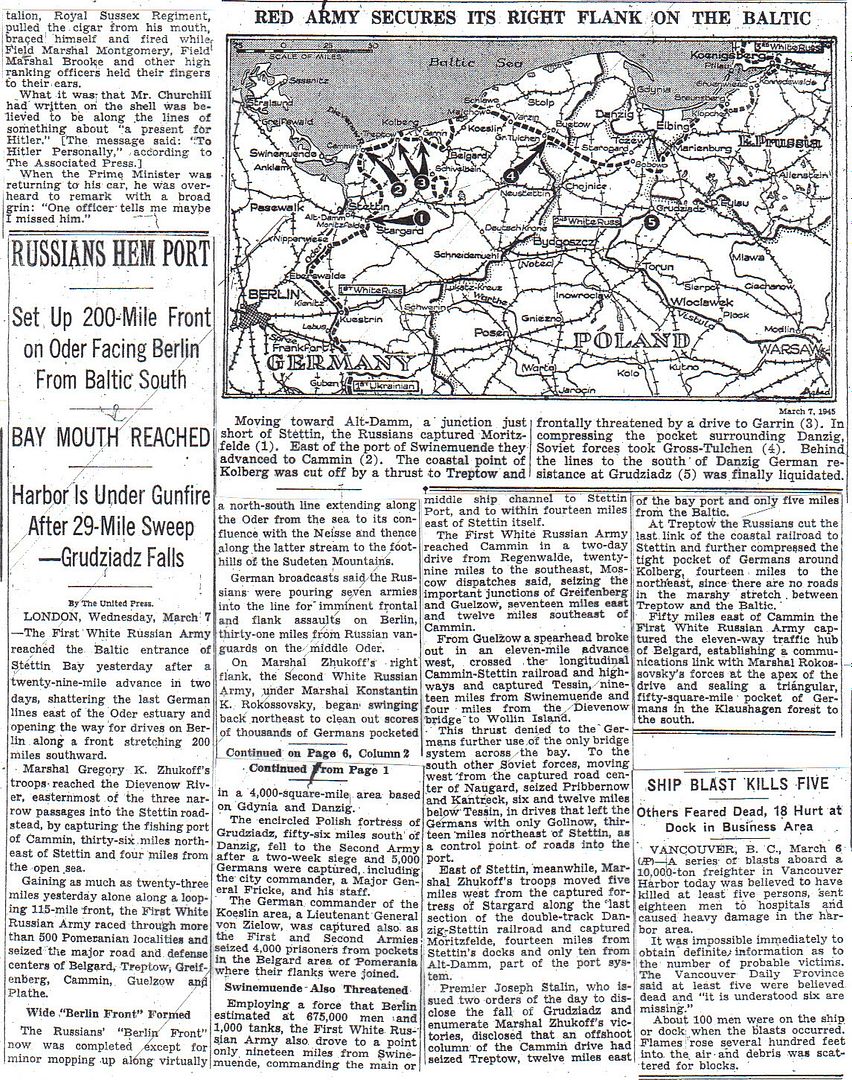
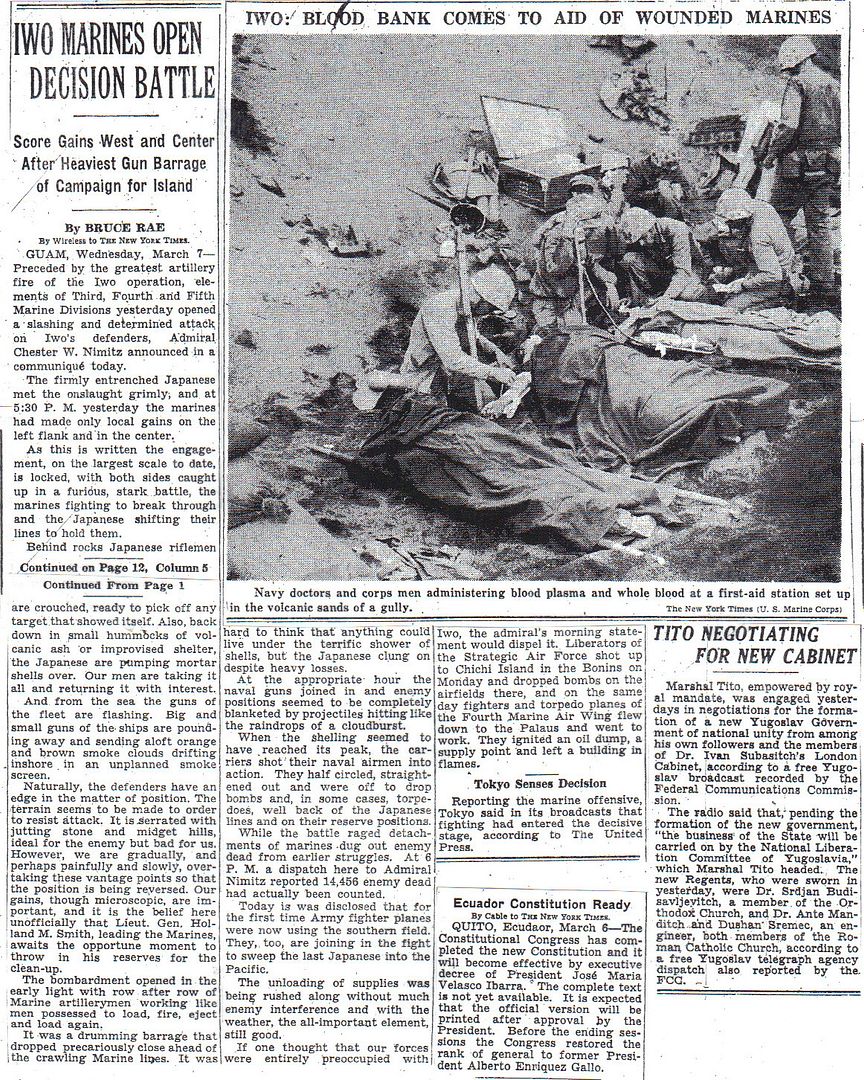
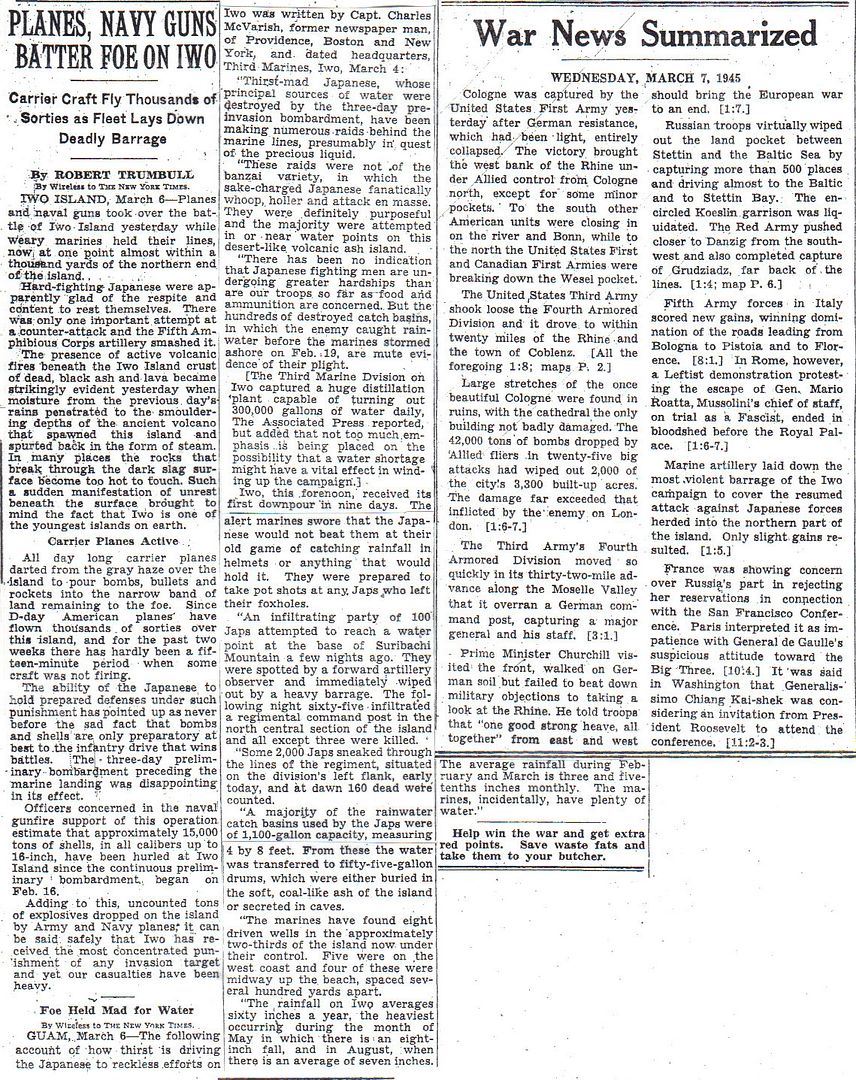
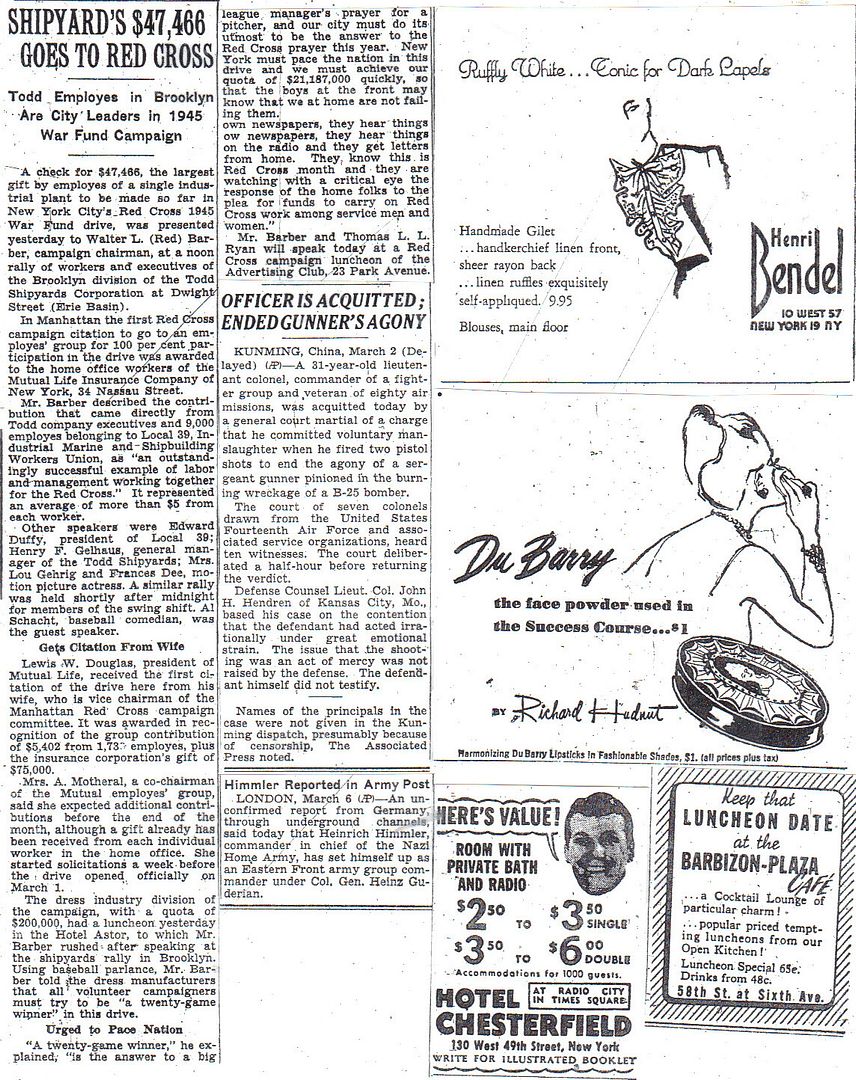
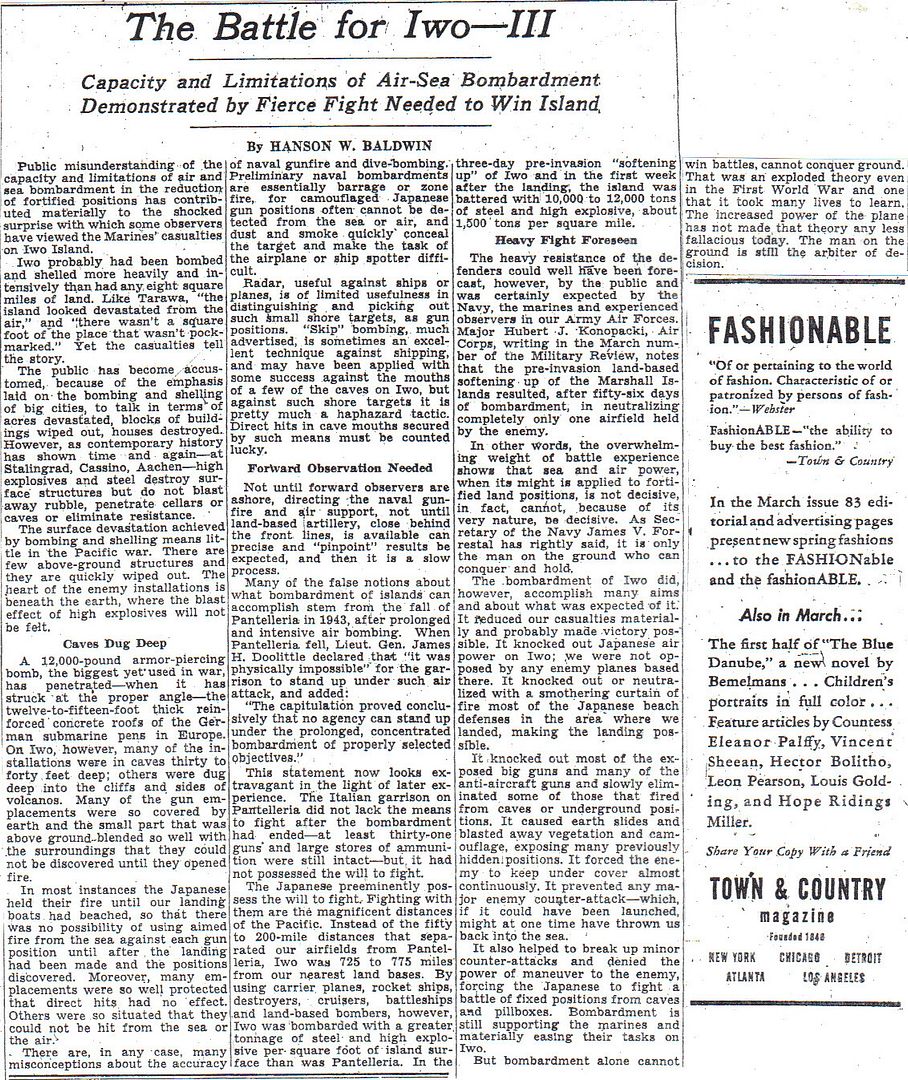
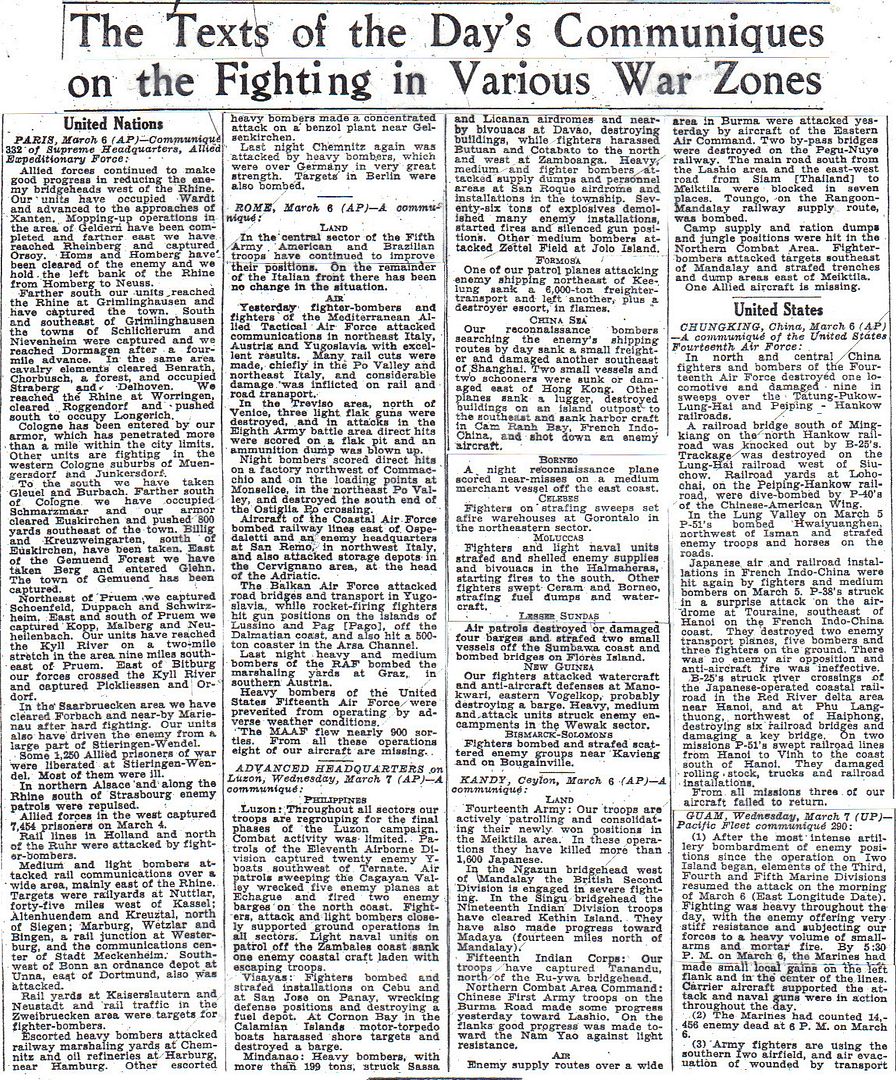
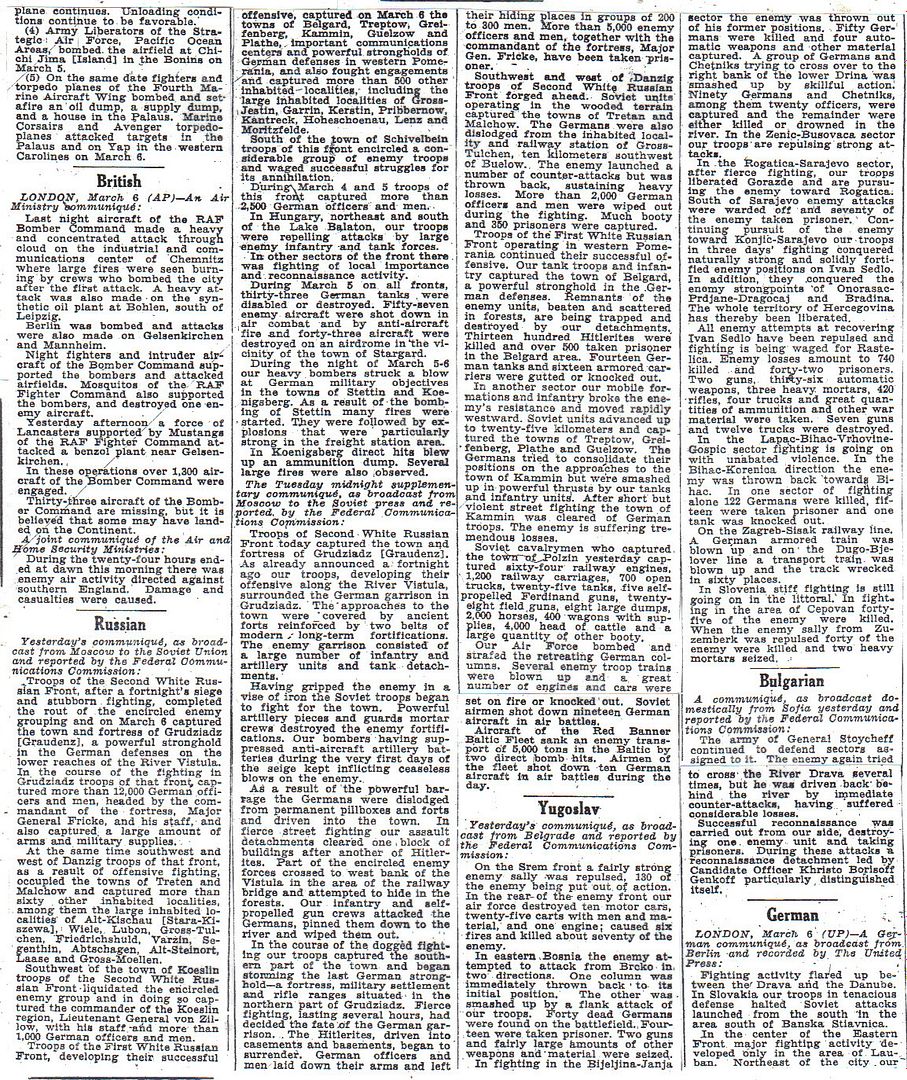
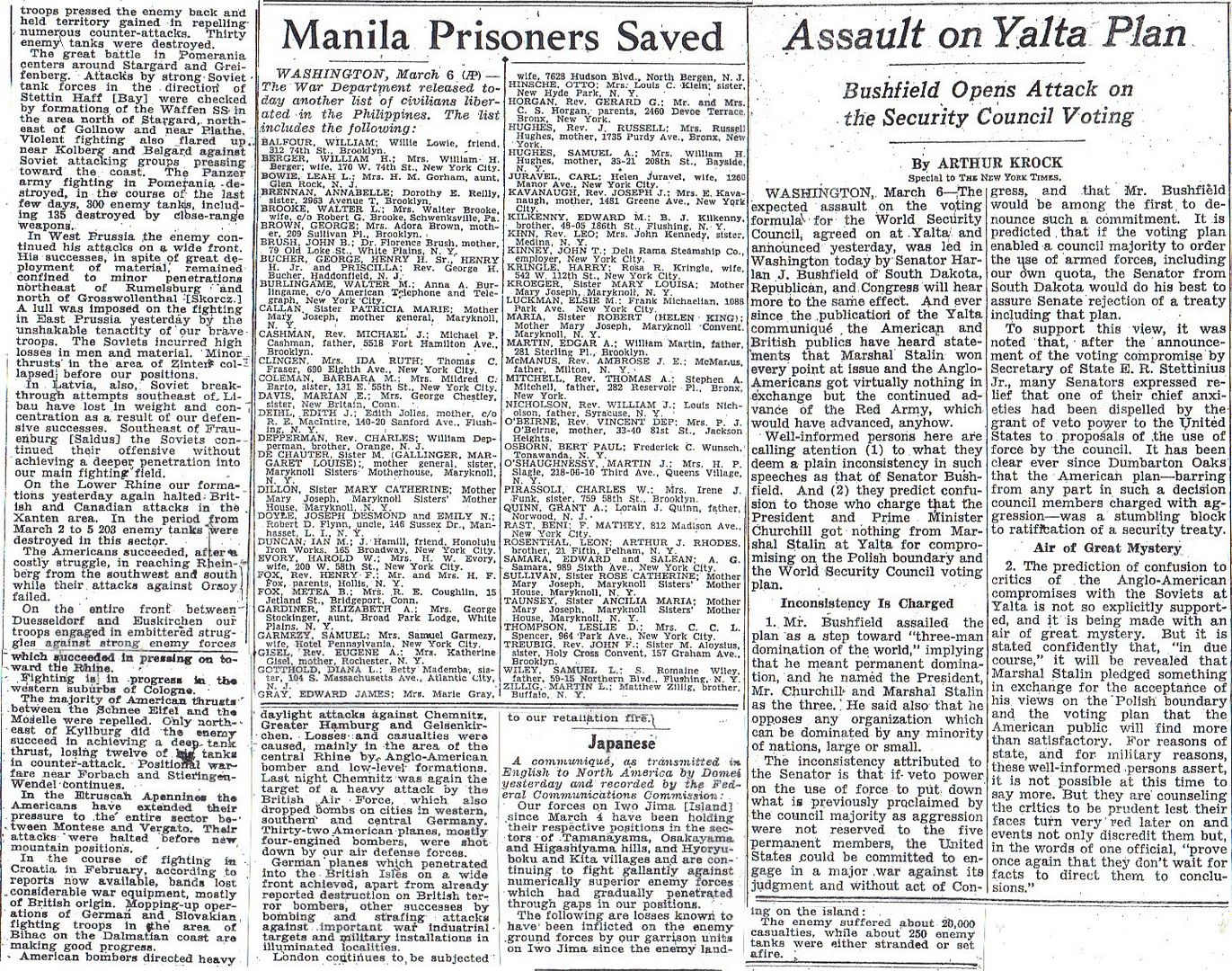
I thought the Polish divisions in Italy had been equipped with British equipment. Is there no more of this available? It would at any rate be desirable to begin the equipment of these two extra Polish units, and for this purpose we should not hesitate to draw upon reserves.
2. In regard to the exact scale of equipment, a considerable tolerance should be allowed. No rigid rule should apply to formations which will be useful and necessary as the war draws to a close but which may not have to sustain its brunt. The use of these Polish units in occupying Germany will take the strain off our man-power, which will be of great importance to us in the period immediately following the collapse of Germany. For this purpose they would not require the equipment, transport, etc., which has been deemed necessary to full combat readiness.
Winston S. Churchill, Triumph and Tragedy
http://www.etherit.co.uk/month/2/07.htm
March 7th, 1945 (WEDNESDAY)
IRISH SEA: U-1302 (type VIIC/41) is sunk in St. George’s Channel in position 52.19N, 05.23W, by depth charges from the Canadian frigates HMCS La Hulloise, Strathadam and Thetford Mines. 48 dead (all hands lost). U-1302 was “made” by radar by HMCS Strathadam then by Asdic, and followed by a sighting of a periscope and Schnorkel. While La Hulloise and Thetford Mines held sonar contact, Strathadam made a Hedgehog bomb attack which produced a definite hit, there was a “spectacular underwater flash” a huge air bubble and wreckage, followed moments later by a submarine breaking the surface. Further attacks produced sufficient material to confirm the end of U-1302.
U-246 (type VIIC) reported for the last time from position 56.20N, 12.50W while enroute for its operational area in the Irish Sea. Lost during April 1945 in the Irish Sea south of the Isle of Man, in position 53.40N, 04.53,5W.
Listed as missing on 5 April, 1945. No explanation exists for its loss. 48 dead (all hands lost). On 25 October, 1944 an escort attacked U-246 with depth charges and damaged her so seriously that she had return to base.
(Alex Gordon)
GERMANY: The US III Corps reaches Remagen and send advance units across the Ludendorff Bridge. This is the first crossing of the River Rhine.
The US First Army under General Courtney Hodges reached the Rhine at Cologne today and found all the bridges down. Some 30 miles to the south, however, Second Lieutenant Emmet J Burrows came out of the woods above Remagen to find the disorganized German troops fleeing across the intact Ludendorff railway bridge.
Soon a platoon of US tanks was charging down to the bridge. As it approached a German engineer detonated charges which created a small crater. The Americans pushed on, shelling the German on the east bank. One shell knocked out the engineer responsible for firing the demolition charges. When he came to and turned the key, nothing happened. He tried again and still the detonators failed. An army sergeant raced onto the bridge and amid a hail of American gunfire, ignited a fuse. A powerful explosion lifted the bridge up; it settled back and, incredibly, still stood. General Bradley (C-in-C of the 12th Army Group) exclaimed to Hodges: “Hot dog, Courtney! This’ll beat him wide open. Shove everything you can across it.”
U-2543 commissioned.
NORWAY:
U-548 sailed from Norway on her final patrol.
U-1023 sailed from Norway on her first and final patrol.
POLAND: The Germans start to evacuate Danzig.
HUNGARY: Budapest: Hitler, in a desperate attempt to recapture Budapest and the Hungarian oilfields, launched Operation Spring Awakening yesterday with two Panzer armies attempting an encircling movement around Lake Balaton. The southern arm has the extra task of disrupting the Russian advance on Vienna.
First reports from the battlefield tell of minor German gains as their tanks flounder in a sea of mud. It is also obvious the Russians knew of the attack and prepared deep defensive positions.
EASTERN FRONT: Marshal Zhukov, striking north to the Baltic, has smashed the 3rd Panzer Army and has cut off Stettin from the sea. According to German reports Zhukov is mounting heavy attacks along a 100-mile stretch of the Oder running from the south-east of Berlin to the approaches to Stettin.
One of the main points under attack is the fortress of Kustrin, 40 miles due east of the German capital. A communiqué from the German high command says that the Russians intend to eliminate it before attacking Berlin.
Meanwhile, Marshal Rokossovsky continues to clear Pomerania. His men captured the German stronghold of Grudziadz, outside Danzig, yesterday.
BURMA: Chinese forces capture Lashio.
CANADA: Frigate HMCS Wentworth arrived Shelburne , Nova Scotia for refit.
Fire tug HMCS Nashwaak assigned to Sydney, Nova Scotia.
Frigates HMCS Charlottetown, Springhill and Stettler departed Halifax for EG-16 Londonderry.
From Atkinson’s. “The Guns at Last Light”
Hodge’s on Wednesday, March 7, reported Cologne had fallen. Yet so had the city’s link to the east bank of the Rhine: a twelve hundred-foot segment of the Hozenzollern bridge had been blown into the river at noon the previous day. First Army’s hopes for an early crossing seemed ever more faint.
“The Rhine. I don’t know what I expected. Another Mississippi, I suppose,” an engineer sergeant told his diary. “The damn thing flow north.” Indeed it did. From Switzerland, where the river was fed by 150 glaciers, to the North Sea, the European father of waters formed an extraordinary moat against invasion from the west. Although it was only the world’s fifteenth-largest river in volume, ranking between the Euphrates and the Rhone, the Rhine was broad, deep and fast enough that engineers compared any crossing to “a short sea voyage”. “At no place is the river fordable, even at low water,” the U.S. Army Corps of Engineers reported, and winter floods had been the highest in a quarter century, with currents in some stretches approaching eleven miles an hour. Most of the thirty-one Rhine bridges within Germany had been demolished by men with a rare aptitude for destruction. Thanks to the aerial bombardment of German factories, the river flowed relatively unpolluted for the first time in a generation, but so much wreckage clogged its bed that the Allies could not simply sail upstream from Nijmegan. A “top-secret and private” note from Churchill’s office to Beetle Smith likened the difficulties faced by seven Allied armies in catapulting eighty division across the river to another D-Day.”
Plans to jump the Rhine had been drafted even before the Normandy landings. Exhaustive studies examined bank, current, weather, and ice conditions, as well as Roman accounts of erecting a trestle bridges before the birth of Christ, and French records of nineteenth-century pile-driving near Strasbourg. Army engineers in Vicksburg, Mississippi, scrutinized historical hydrology data, aided by intelligence agents in Switzerland and daily gage readings intercepted in German radio broadcasts to river pilots. More than 170 models of the Rhine were built, and hydraulics laboratory in Grenoble conducted elaborate experiments. A Rhine River Flood Prediction Service opened in January; mindful of the Roer debacle, diplomats pressed the Swiss to protect seven headwater dams with soldiers and artillery.
River-crossing schools on the Loire trained hundreds of outboard-motor operators, pile-driving specialists, and DUKW drivers. A steel mill in Luxembourg extruded 54,000 tons of massive I-beams for bridge building. Boatyards in Florida, Minnesota, and Michigan built hundreds of seventeen-foot plywood craft designed to carry a dozen riflemen and three engineers each; nested and crated in clusters of six, the vessels were whisked to Europe by cargo plane or fast ship. French boatwrights, shown a photograph of a storm boat in January, set to work using blueprints drawn by a naval architect. Trees were felled, plywood milled, and screws and nails fashioned from surplus wire; five weeks after placing the order, the U.S. Army picked up seven hundred boats. Seagoing landing craft, capable of carrying a Sherman tank or sixty men, sailed from England to Antwerp and up the Albert Canal before being hauled overland to the Rhineland on trailers so enormous that bulldozers led the convoys to knock down any building crimping the roadway. Other big craft for this “inland navy” were trucked three hundred miles from Le Havre; they arrived, a witness reported, “festooned with treetops, telephone wires, and bits of buildings from French villages.”
By early March, forward depots contained 1,100 assault boats, 124 landing craft, 2,500 outboard motors, 5 million board feet of lumber. 6,000 bridge floats, and enough steel and pilings to build more than 60 bridges. Everyone agreed, however, that it would be far simpler to capture one already built.
Just such a bridge still stood fifteen miles south of Bonn at Remagen, an ancient Roman town straddling a road built by Marcus Aurelias. Here the Rhine scoured a curving basalt gorge: to the north, Siegfried has slain his dragon at Drachenfels, bathing in the creature’s blood to become invulnerable; to the south, Julius Caesar built two spans over the river in 55 B.C and 52 B.C., during the Gallic campaigns. The current bridge had been completed in 1918 and named for General Erich Ludendorff, the progenitor of the final, fatal German offensive on the Western front in the Great War. More than a thousand feet long and wide enough for two trains to pass abeam, the span featured symmetrical arches resting on four stone piers, with embrasured stone towers at either end. Wooden planks could be laid on the rail tracks to permit motor traffic. On the east bank, the tracks vanished into the Dwarf’s Hole, a tunnel bored through the steep six-hundred-foot hill called the Erpeler Ley. Local esthetes complained that the bridge marred the dramatic riverscape; they complained more when it drew repeated Allied air attacks, including a January raid that killed three dozen civilians.
Retreating German soldiers had tramped across the Ludendorff in late 1918, and now retreating German soldiers were tramping over it once again, mingling with refuges, livestock, and an occasional hospital train carrying broken boys. A teenage antiaircraft gunner described a snaking procession making for the bridge through Remagen’s jammed streets on Wednesday morning, March 7, “with cannons being pulled by horses, by motor vehicles, and yes, even by soldiers.” Fewer than a thousand defenders remained in the area; most were Volkssturm militia of doubtful martial value, and all fell under a confused, fractured command architecture. Filed Marshal Model had promised reinforcements, but none arrived.
Sixty zinc-lined boxes for explosives had been fitted to the bridge in 1938, linked by cables through heavy conduits to an electrical firing switch inside the rail tunnel. The premature blowing of a bridge near Cologne-apparently triggered by an American bomb-had led to a Fruhrer order that explosive charges would be emplaced only when the enemy was within five miles of a bridge, and igniters were to be withheld until “demolitions seems to be unavoidable.” On Wednesday morning, sketchy reports put U.S. Army outriders near the Western bluffs above Remagen. Explosives were laid, but Army Group B described the Americans as a thin screening force to mask an Allied thrust towards Bonn and Cologne. Little urgency obtained.
Their enemy was nearer than they knew. On the previous night, March 6, the U.S. III Corps commander, Major General John Milliken, had phoned Major General Joh W. Leonard, commander of the 9th Armored Division. “Do you see that little black strip of a bridge at Remagen?” Milliken asked as both men squinted at their maps. “If you happen to get that, your name will go down in glory.”
At 8:20 a.m. on this gray, misty Wednesday, a tank-and-infantry task force left Meckenheim, ten miles from the river. Leading the column in the advance guard was Lieutenant Karl H. Timmermann, who had command of Company A of the 27th Armored Infantry Battalion for less than twenty-four hours. Timmermann had been born not far to the southeast, in Franfurt; his doughboy father had taken a German war bride in 1919 before moving back to Nebraska. In a note scribbled in a Meckenheim cellar, the weary young offer told his wife:
There is no glory in war. Maybe those who have never been in battle find [a] certain glory and glamour that doesn’t exist….Tell mom that we’ll be on the Rhine tomorrow.
Now Lieutenant Timmermann would prove himself wrong: for a brief vivid moment glory would be his. Summoned by two waving scouts shortly before one p.m. he hurried forward in his jeep to find a hazy, panoramic view of the Rhine gorge below. “Jesus, look at that,” a sergeant muttered. “Do you know what the hell river that is?” Through field glasses Timmermann watched cows, horses, soldiers, trucks, and civilians cross beneath the bridge arches in a lumbering parade. Just below, white flags and bedsheets flapped from Remagen windowsills. Two locomotives with steam up stood on the far bank.
As three platoons descended through the town, leapfrogging from doorway to doorway, Timmermann bounded past the handsome St. Apollinaris Church and a sign that read, “Citizens and Friends: Preserve Our Parks.” A spatter of German musketry provoked booming return fire from a platoon of new M-26 Pershing tanks, each brandishing a 90mm gun. Tearful Germans pointed to cellars where Volkssturm stragglers crouched in terror. A captured enemy general in an elaborately braided uniform proved upon interrogation to be a railroad station agent.
Shortly before 2 p.m. a dark geyser of earth and paving stones abruptly blossomed above the western ramps; the blast left a smoking hole thirty feet wide, intended to keep American tanks from gaining the bridge. Heckling gunfire erupted from the Ludendorff towers. Bullets pinged and sparked among the girders. GIs fixed bayonets before darting past the last houses above the river. “I’ll see you on the other side,” the 27th Armored Infantry commander told Timmermann “and we’ll all have a chicken dinner… Move on.” Timmermann raked the far bank with his glasses. Tiny figures loped along the shoreline and into the tunnel. “They look like they want to get us on the bridge before they blow it up,” he said.
Barely a half mile away, pandemonium swept the Eastern shore. Civilians and shrieking children cowered in the Dwarf’s Hole as billowing smoke from the white-phosphorus shells drifted down the tunnel. German soldiers ran this way and that along the bridge ramp, including several engulfed in orange flame from American tank shells chewing up the riverbank and smacking the Erpeler Ley. Three junior officers argued over whether the demolition order should be put in writing. Shouts of “Blow the bridge!” carried across the water, and at length a captain shouted, “Everybody lie down! Open your mouth to protect your eardrums.” He turned the key on the firing switch.
Nothing happened. He turned it again, and again, without effect. A German sergeant sprinted ninety yards onto the bridge, lighted the primer cord by hand, and pelted back to the tunnel, chased by bullets.
With a doleful boom the timber planks rose from the railbed like jackstraws. Dust and black smoke boiled from the piers. The Ludendorff seemed to levitate momentarily as if expending a great sigh, then settled back onto its stone foundations, insulted but intact.
No one would ever be certain why fourteen hundred pounds of explosives failed to detonate properly: faulty charges, faulty blasting caps, perhaps a tank shell that severed the main demolition cable, perhaps some averred, a miracle.
Reprieved, Lieutenant Timmermann and his men raced onto the bridge, slashing wires and pitching charges into the water. Four Pershing tanks and a dozen Shermans arrayed on the west bank hammered the eastern tower until riflemen could clear out a German machine gun nest. Sergeant Alex Drabik of Toledo reached the far bank first, in a zigzagging, stumbling sprint that cost him his helmet. Eight others followed on his heels, including Timmermann.
By late afternoon, Company A had 120 men across. A platoon began to scale the Erpeler Ley, dodging stones rolled down the slope by the flak battery holding the crest. After a single warning shot, five German engineers surrendered in the Dwarf’s Hole; GIs blew apart the main demolition switch with a carbine. A 90mm tank round from across the river smashed through a German locomotive tugging a long string of boxcars, and the train halted with a sharp lurch, a white plume of steam sighing from the firebox. GIs crouched in a ditch as a passenger train from the north pulled into the tiny Erpeler station; middle aged soldiers with rifles spilled onto the platform only to be greeted with mispronounced shouts of “Hande hoch.” A single German guard at the Eastern exit of the rail tunnel also was seized, and twenty minutes later two hundred others emerged under a white flag to march in their long leather coats, hand high, across the bridge they had neither saved nor destroyed. Before surrendering, Captain Willi Bratge, the Remagen commandant, told a subordinate to deliver a message to the German high command. “Inform then that the demolition of the bridge was unsuccessful,” Bratge said, “and that the Americans have crossed.”
Night fell, a sodden, moonless night, “dark as a pocket,” as one officer recorded, so dark that engineers felt for the street curbs in Remagen with their feet. Bulldozers slowly filled the crater on the western ramp and three artillery battalion unlimbered. Soldiers ripped lumber from German houses to patch the rail planks. Exhausted drivers napped at their wheels as great knots of convoy traffic converged at the bridge, awaiting orders to cross. By ten p.m. three depleted rifle companies occupied the far shore, thwarting a counterattack by a hundred German engineers and antiaircraft crewman who were repulsed near the Erpeler Ley while carrying half a ton of explosives.
At last nine Shermans - narrower than the Pershings – crept across at midnight, guided by foot soldiers wearing luminous buttons on their belts. German tracer fire searched the span, usually a few feet too high. “ominous and nerve wracking creaking” rose from the bridge, a captain reported, all the more ominous when the tenth vehicle to cross, a tank destroyer, skidded to the right near one of the eastern piers and plunged partway through a hole in the deck. For several hours- “the most harrowing minutes of my life,” one officer acknowledged – the vehicle remained stuck, blocking all traffic. Engineers debated pushing it over the side, or jacking it up, or winching it out, or blowing it to pieces. Just as dawn peeked above the Erpeler Ley, the damnable thing was muscled out and towed away. The desperate effort to deepen the bridgehead resumed apace, through what a Wehrmact general now called “the inner door to Germany.”
Thank you for your persistence in presenting the History of WWII. People don’t realize how relavant that is to today’s world, because we are making the same mistakes. Please continue to provide this factual historical record as it is important that we not forget the past...
Easy for Churchill to say, since the Russians will have to assault Berlin.
Thanks for that account. Much appreciated.
I have to say, for the past 5 or so months, I've been rather underwhelmed with the reported results of these B-29 bombings.
Its good that we have a plane capable of reaching Japan but my expectations have been for more dramatic results than we've been hearing about. Especially since it doesn't appear to be meeting significant fighter opposition over Japan.
In class we learned from Mr. Simpson that a B-29 carries 4 times the payload of a B-24 making the upcoming 300 plane strike against Tokyo equivalent to a 1,200 B-24 strike against Berlin.
If we don't hear significant results from this upcoming raid, we are going to have to begin questioning command level decision making.
It would have been interesting to be following this at home. I imagine reading the paper aloud and tracking the progress on my own map.
One prisoner who was asked if he thought Berlin might become another Stalingrad simply shrugged his shoulders and said;
“Impossible, There is not enough left standing to convert into fortifications.”
We cleaned out our family home about 10 years ago. Grandparents hadn’t thrown out much since they moved in around 1922.
There was a large steamer trunk with newspapers and magazines from WW2, somewhat in order. Fascinating!
Also complete sets of outdoor mags from the 1930s through the early ‘60s.
OFFICER IS ACQUITTED; ENDED GUNNER’S AGONY
.................... Defense Counsel.................based his case on the contention that the defendant had acted irrationally under great emotional strain. The issue that the shooting was an act of mercy was not raised by the defense..................
underwhelmed with the reported results of these B-29 bombings.
Mercy killings are forbidden for a number of reasons. One being it isn't the role of untrained soldiers to make medical decisions as to which type wound is, or is not recoverable.
Except we already learned in class that the pre-invasion bombardment of Iwo was undersized for at least two reasons; First being the navy wanted to make a big show by striking Tokyo. Second was that the ammunition allocation for the naval bombardment of Iwo was not expended before the first wave went ashore.
Except we already learned
There is an overexpecation of bombing. But it is better than no bombing.
Disclaimer: Opinions posted on Free Republic are those of the individual posters and do not necessarily represent the opinion of Free Republic or its management. All materials posted herein are protected by copyright law and the exemption for fair use of copyrighted works.